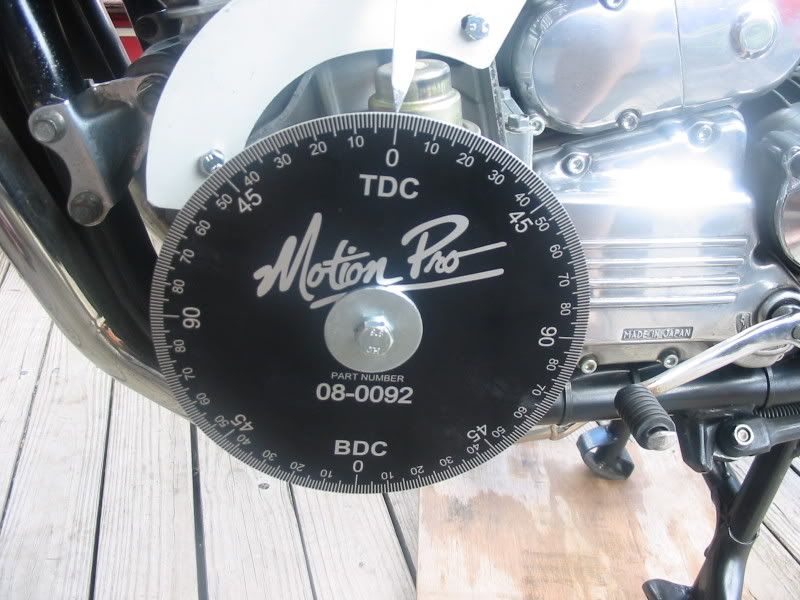I just put the valves together and assembled the cylinder heads. Now the manual tells that I need a "dial" to make sure that two pistons are full top. Can anyone tell me where I can get the dial and where to insert it?
Timing Help Needed
Collapse
X
-
Timing Help Needed
Sam Christensen
The Chronicles of my Rebuild http://xs1100rebuild.blogspot.com
--------------------------------------------------------
If you are leading and no one is following, maybe your just taking a walk.
Currently bikeless. Sold my 1980 XS1100 SpecialTags: None -
It's saying to use a dial indicator to find exact TDC by placing the end in the spark plug hole. You should be able to "eye" it by putting a soda straw or similar down the #1 plug hole and rotate the crank till you find the top. Do this before putting on the timing (cam) chain. Your pointer should line up with the T mark.Last edited by bikerphil; 05-25-2009, 08:59 PM.2H7 (79) owned since '89
3H3 owned since '06
"If it ain't broke, modify it"
☮ -
I assume you are talking about making sure your pistons are at top dead center with a dial indicator? A dial indicator can be bought at Harbor Freight pretty inexpensively. Make sure you get the magnetic stand or mount for it to, cheap but worth while device!
The idea is that there is a "lag" where the crank is rotating through the max lift point of the piston so the piston does not move but the crank does. The center of this rotational period of no movement in the piston is TDC. So you need to have a dial indicator set where the piston will contact it. And also a method of marking the crank shaft rotation so you can indicate where movement stops and where it begins in the rotation. Again center of that spot is TDC. Typically this is doen with the head off, but you might be able to get it from putting a dowel or somehting like that in your spark plug hole and letting it push on the indicator?? Never done it this way myself.
This is also referred to as degreeing a cam IIRC. There is an excellent pictorial writeup of this somewhere on the site.
Phil of course beat me to it.
Phil, if you rebuild the engine so you not need to re-establish the pointer location to true TDC as indicated above? Seems I have read that pointer is movable and needs to be "calibrated" to true TDC.Last edited by DGXSER; 05-25-2009, 09:04 PM.Life is what happens while your planning everything else!
When your work speaks for itself, don't interrupt.
81 XS1100 Special - Humpty Dumpty
80 XS1100 Special - Project Resurrection
Previously owned
93 GSX600F
80 XS1100 Special - Ruby
81 XS1100 Special
81 CB750 C
80 CB750 C
78 XS750Comment
-
The dial indicator should reach down the spark plug hole enough to reach the piston at TDC, least the one I have (Harbor Freight) does.
What you say is true. I usually mark where the indicator was before removing it. The soda straw method should be plenty accurate to make sure the pointer is lined up with the T mark. I've done it several times without a dial indicator.2H7 (79) owned since '89
3H3 owned since '06
"If it ain't broke, modify it"
☮Comment
-
There are many ways to find TDC but there is really only one way to find EXACT top dead center. You need a degree wheel and a piston stop or a dial indicator. For me a piston stop is so much easier to use.
True TDC is the exact center of the 5 or 6 degrees of crank rotation where the crank throw is going over the top. The piston is actually still moving but it is almost unmeasureable. A piston stop takes the guesswork out of it all because you are not trying to read a dial as you are turning the motor over and you are making the measurements about 15 degrees of rotation away from the piston dewll. A piston stop is easy to make from a bolt and an old spark plug. I made mine from an adaptor from an old compression gauge. But if you do use a dial indicator for this, make sure it is mounted on the motor and not on the frame because the flex of the motor mounts can give you a false reading as you turn the crank over. The timing wheel on the left side of the motor is basically useless for this.
If you are going to get into degreeing cams, etc. then you really need a good degree wheel, dial indicator and a piston stop because the measurements must be exact or you may end up with a piston to valve collision if you are too far off.
In fact, once you gather all this stuff you will never use your timing wheel again. It only takes about 5 minutes to set up your degree wheel at TDC and it is always repeatable. I even set my degree wheel to just check ignition timing since it is so much more accurate than the timing wheel. My timing plate remains on the motor only to hold the timing plate and advance mechanism on.
Piston Stop

Degree Wheel at TDC
 Mike Giroir
Mike Giroir
79 XS-1100 Special
Once you un-can a can of worms, the only way to re-can them is with a bigger can.Comment
Comment